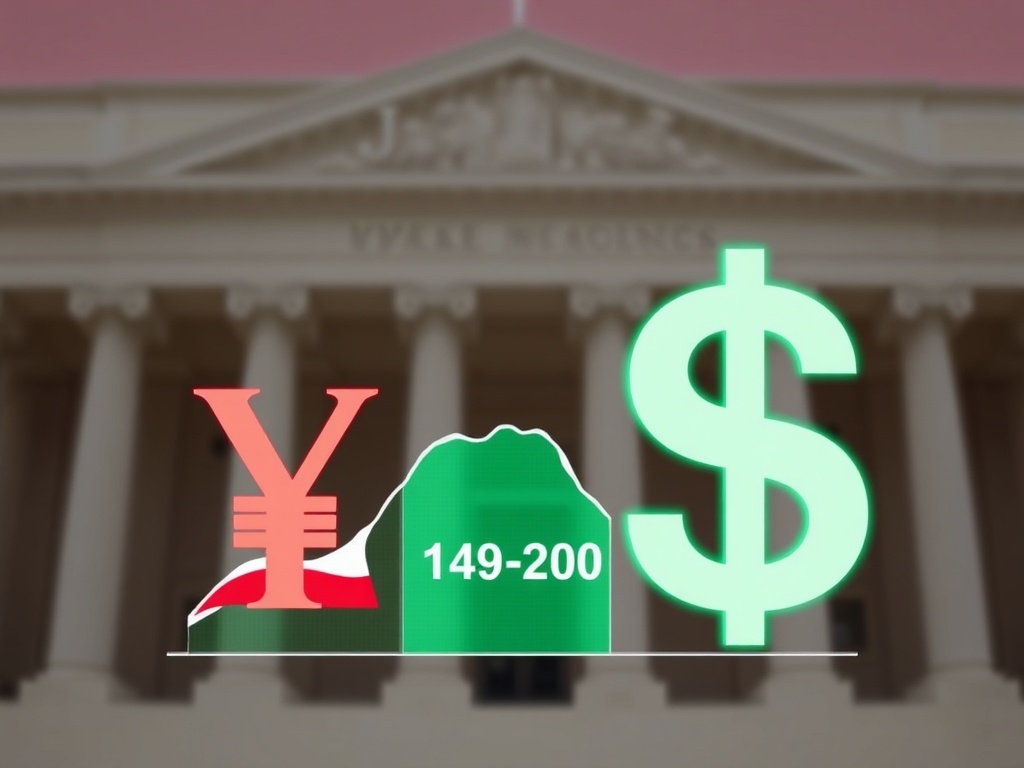USDJPY Forecast: UBS Unveils Pivotal Ceiling at 148-150
BitcoinWorld
USDJPY Forecast: UBS Unveils Pivotal Ceiling at 148-150
The world of finance is a complex web, where movements in one market can send ripples across others, including the dynamic cryptocurrency space. For investors and traders alike, understanding macro-economic shifts is not just an advantage; it’s a necessity. Recently, a significant development emerged from the banking giant UBS, whose latest USDJPY forecast has captured the attention of market participants globally. UBS now projects a crucial ceiling for the USDJPY pair between 148 and 150, a perspective that could redefine strategies for those engaged in currency trading and influence broader investment decisions.
UBS’s Pivotal USDJPY Forecast: Unpacking the Numbers
UBS’s revised USDJPY forecast represents a notable shift in their outlook, suggesting a more contained upside for the pair than previously anticipated. The projection of 148-150 as a ceiling implies that while the US Dollar may continue to find some strength against the Japanese Yen, its upward momentum is expected to face significant resistance at these levels. This forecast is not merely a number; it reflects a deep analysis of various macro-economic factors, including central bank policies, interest rate differentials, and global economic sentiment.
For context, the USDJPY pair has been a focal point in the Forex market analysis due to the stark divergence in monetary policies between the United States Federal Reserve and the Bank of Japan (BoJ). The Fed’s aggressive rate hikes aimed at combating inflation have bolstered the US Dollar, while the BoJ has maintained an ultra-loose monetary policy to support its economy. This interest rate differential has historically driven the USDJPY higher.
However, UBS’s updated stance suggests that this differential might be nearing its peak impact, or that other factors are beginning to weigh more heavily. A ceiling between 148 and 150 indicates that the bank sees the current drivers of JPY weakness potentially exhausting themselves, or that counteracting forces are gaining traction. This could be due to an anticipated slowdown in Fed rate hikes, potential hints of a BoJ policy shift, or simply a market correction based on overextension.
Understanding this ceiling is crucial for anyone involved in the global financial landscape. It provides a potential benchmark for risk assessment and strategic planning, influencing everything from corporate hedging decisions to speculative trades. For those in the crypto world, while not directly correlated, the stability or volatility of major currency pairs like USDJPY can impact overall market sentiment and liquidity, as traditional finance often dictates the broader economic narrative.
Navigating the Dynamic Forex Market: What’s Driving USDJPY?
The Forex market analysis surrounding USDJPY is multifaceted, driven by a confluence of economic indicators, central bank rhetoric, and geopolitical events. To appreciate UBS’s forecast, it’s essential to grasp the key elements that typically influence this pair.
Key Drivers of USDJPY:
- Interest Rate Differentials: This is arguably the most significant factor. When the interest rates in one country are substantially higher than in another, investors tend to flock to the higher-yielding currency, creating demand. The large gap between US and Japanese interest rates has been a primary propellant for USDJPY.
- Monetary Policy Divergence: The Federal Reserve’s hawkish stance versus the Bank of Japan’s dovish approach has been a defining feature. Any hint of a shift from either central bank can trigger significant movements.
- Safe-Haven Flows: The Japanese Yen traditionally acts as a safe-haven currency during times of global economic uncertainty or geopolitical tension. However, in recent years, this role has been challenged, especially when combined with negative interest rates. The US Dollar also serves as a safe haven, creating a complex dynamic.
- Global Economic Outlook: A strong global economy generally supports riskier assets, which can sometimes weaken safe-haven currencies like the JPY. Conversely, a downturn can increase demand for safe havens.
- Commodity Prices: Japan is a major importer of energy and raw materials. Higher commodity prices can lead to a larger trade deficit for Japan, putting downward pressure on the Yen.
The interplay of these factors creates a constantly evolving landscape. For instance, if the market anticipates the Fed will soon pivot to rate cuts, the interest rate differential would narrow, potentially weakening the USD against the JPY. Conversely, if the BoJ signals a delay in tightening, the JPY could remain under pressure. UBS’s prediction considers how these forces are expected to balance out, leading to their projected ceiling.
The Resilient Japanese Yen Outlook: A Deep Dive into its Recent Performance
Despite significant headwinds, the Japanese Yen outlook remains a topic of intense debate. For much of the past year, the JPY has been one of the weakest major currencies, largely due to the Bank of Japan’s commitment to its ultra-loose monetary policy, including negative interest rates and yield curve control (YCC).
Challenges Faced by the Japanese Yen:
- Persistent Monetary Easing: The BoJ has been an outlier among major central banks, resisting the global trend of rate hikes. This has made the JPY less attractive to yield-seeking investors.
- Inflationary Pressures: While Japan has historically struggled with deflation, recent global inflation has pushed up import costs, eroding the purchasing power of the Yen and contributing to a negative terms of trade.
- Energy Dependency: As a country heavily reliant on energy imports, Japan’s economy is particularly vulnerable to spikes in global oil and gas prices, which necessitate converting JPY into USD to pay for these imports, thus weakening the Yen.
- Government Debt: Japan has one of the highest public debt-to-GDP ratios in the developed world, which, while largely domestically held, can be a long-term concern for currency stability.
However, there are also arguments for potential JPY strength. As inflation finally picks up in Japan, albeit slowly, there’s growing speculation about a potential shift in the BoJ’s policy. Even a subtle tweak to YCC or an exit from negative rates could significantly impact the Yen’s trajectory. Furthermore, if global economic growth slows, the JPY’s traditional safe-haven appeal could re-emerge, offering some support. UBS’s forecast of a ceiling suggests they see these potential tailwinds for the JPY, or at least a deceleration in the USD’s strength, as increasingly probable.
Understanding the UBS Currency Prediction: Why 148-150 is the Ceiling
What underpins the UBS currency prediction of a 148-150 ceiling for USDJPY? This outlook is likely a result of their proprietary economic models, combined with their assessment of future central bank actions and global economic dynamics. UBS’s analysts are likely factoring in several key assumptions:
- Peak Fed Hawkishness: UBS might believe that the Federal Reserve is nearing the end of its rate-hiking cycle, or that future hikes will be less aggressive. Any signal of a dovish pivot from the Fed would reduce the appeal of the US Dollar.
- Potential BoJ Policy Adjustment: While the BoJ has been steadfast, mounting domestic inflationary pressures and a weakening Yen might eventually force a policy review. Even a minor adjustment, such as widening the band for its yield curve control, could provide significant support for the JPY.
- Valuation Considerations: At certain levels, a currency pair can become significantly overvalued or undervalued based on purchasing power parity (PPP) or other long-term valuation metrics. UBS might see the 148-150 range as approaching a point where the JPY is fundamentally undervalued, making further depreciation less sustainable without strong fundamental drivers.
- Global Economic Slowdown: A global recession or significant economic slowdown could prompt a flight to quality, potentially benefiting the JPY as a traditional safe-haven, or at least dampening the demand for the risk-on US Dollar.
It is important to note that forecasts are not guarantees. Other financial institutions might hold different views. Some might foresee the USDJPY breaking higher if the Fed remains hawkish longer than expected, or if the BoJ maintains its ultra-loose policy indefinitely. The strength of UBS’s analysis lies in its comprehensive approach, integrating these complex variables to arrive at a specific target range. For investors, this provides a critical data point to consider alongside other analyses.
Actionable Insights for Global Currency Trends and Trading Strategies
For those actively involved in global currency trends and trading, UBS’s USDJPY forecast offers valuable actionable insights. A projected ceiling at 148-150 implies several strategic considerations:
For Traders and Investors:
- Risk Management: If the pair approaches the 148-150 level, traders holding long USDJPY positions might consider tightening stop-losses or taking profits, anticipating potential resistance. Conversely, those looking to short the pair might view these levels as attractive entry points.
- Technical Analysis: The 148-150 range could become a significant psychological and technical resistance level. Traders will likely watch for price action around these points, looking for candlestick patterns or indicator divergences that confirm a reversal or consolidation.
- Central Bank Watch: Close attention to statements from the Federal Reserve and the Bank of Japan will be paramount. Any hints regarding future monetary policy will be key determinants of whether the ceiling holds or is eventually breached.
- Economic Data: US inflation reports, employment figures, and Japanese CPI data will provide crucial clues about the economic health of both nations and their respective central banks’ likely actions.
- Diversification: For crypto investors, while direct correlation is low, understanding major currency movements can inform broader portfolio diversification strategies. A stronger JPY could, for instance, reflect global de-risking, which might also impact appetite for volatile assets like cryptocurrencies.
Challenges and Considerations:
- Volatility: The Forex market is inherently volatile. Unexpected geopolitical events or economic shocks can quickly invalidate forecasts.
- Market Sentiment: Sometimes, market sentiment can override fundamental analysis, leading to irrational exuberance or panic.
- Liquidity: While USDJPY is a highly liquid pair, extreme market movements can still lead to wider spreads and execution challenges.
The UBS forecast serves as a guide, not a definitive outcome. It encourages traders to prepare for potential scenarios and to integrate this perspective into their overall risk management framework. Staying informed about the latest developments in global currency trends is essential for navigating these complex waters effectively.
In conclusion, UBS’s latest USDJPY forecast, setting a crucial ceiling between 148 and 150, provides a compelling perspective on the future trajectory of one of the world’s most closely watched currency pairs. This projection is rooted in a detailed Forex market analysis, considering the evolving monetary policies of the Federal Reserve and the Bank of Japan, alongside broader economic forces. While the Japanese Yen outlook has faced significant challenges, UBS’s currency prediction hints at a potential shift in momentum or at least a consolidation of the current trends. For participants in the global currency trends, this forecast offers invaluable insights for strategic planning, risk management, and identifying potential trading opportunities. As always, vigilance regarding central bank communications and key economic data will be paramount in confirming or challenging this pivotal outlook. The interplay of these forces will continue to shape not just the Forex market, but also broader financial stability, impacting asset classes far beyond traditional currencies, including the ever-evolving world of digital assets.
To learn more about the latest Forex market trends, explore our article on key developments shaping the Japanese Yen outlook and global currency trends.
This post USDJPY Forecast: UBS Unveils Pivotal Ceiling at 148-150 first appeared on BitcoinWorld and is written by Editorial Team
También te puede interesar

Shiba Inu exploded in 2021, PEPE in 2023, this frog token under $0.002 could soar in 2025

Competition in blockchain in Hong Kong heats up, with giants such as JD.com and Ant accelerating the implementation of RWA in Hong Kong
